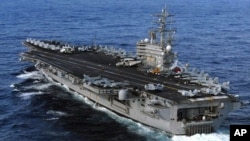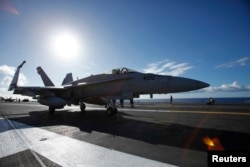Amid the baking surface heat of a vast oceanic expanse, crewmembers of the USS Ronald Reagan go about their business as fighter jets burst from the deck of the enormous aircraft carrier.
Despite the routine activities, today is historic: 10 Cambodian diplomats, including senior officials from the Royal Cambodian Armed Forces and the Ministry of Interior, have come aboard to study real-time naval operations as the vessel plies disputed waters of the South China Sea.
During the rare visit, Cambodians even received hands-on experience commanding take-off and landing, ordering jets on practice missions.
“We are conducting normal operations for a carrier strike group — freedom of navigation, operating in the vicinity of worldwide commerce," said Captain Michael “Buzz” Donnelly, the vessel's commanding officer, who describes their location as roughly halfway between the internationally contested Spratly and Paracel Islands. "Lots of ships have been going through this area, from Australia to Malacca. It is an area that we’re frequently operating in and [conducting] exercises with our friends, allies, and neighbors, to demonstrate our commitment to the freedom of the sea and the freedom of commerce.”
Today is an opportunity "for the Cambodian military and government officials to come out and see exactly what it is for an aircraft carrier to operate on the high seas," he says. "For us to have that exchange ... is nothing but beneficial to our relationship.”
Cambodian Interior Minister Prum Sokha echoed the sentiment, calling the visit vital to maintaining "peace in the region and in the world.”
“What’s important is that joint cooperation requires us to understand one another," Sokha said. "So the visit is a way to do so; not only do we explore the high technology, but also the spectrum of the operation from a joint [perspective].”
Commissioned in 2001, the nuclear-powered USS Ronald Reagan, some 330 meters long and 76 meters wide, replaced the USS George Washington to join to 7th Fleet based out of Yokosuka, Japan, in January 2014. According to Captain Donnelly, the ship carries a crew of more than 5,000, including engineers, doctors, pilots and naval officers, along with some 70 fighter jets, including F-18s, and helicopters and radar planes.
One of its main roles, Captain Donnelly said, is maintaining peace in the contested maritime region. Despite Tuesday's Hague ruling on the South China Sea, which favored the Philippines over China, several Asian states remain at odds with China, which continues to develop artificial islands in the region.
“It is not so much a concern directly to us, because we’re always operating here," said Donnelly, adding that U.S. naval forces have a long history in the region. "Whether we’re going through it, over to the Indian Ocean and to the CentCom area of operations in the Arabian Gulf, or whether we’re just staying here to operate in the West Pacific or in the South China Sea itself, there's nothing unique about our operation here today. We just operate where we choose.”
On Thursday, Sokha, the Cambodian interior minister, said Phnom Penh's ASEAN membership means his country won't interfere in any bilateral disputes between its key ally, China, and fellow ASEAN nations.
“The main operation of each nation is to maintain peace and stability in the region," he said. "As the Cambodian government and Prime Minister Hun Sen have stated concerning the dispute, Cambodia’s position is for bilateral and peaceful resolution.”
This report was produced in collaboration with VOA's Khmer Service.








